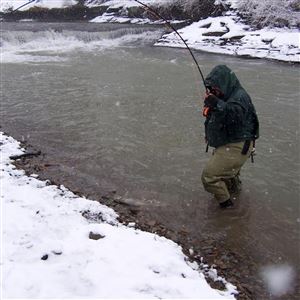When a sheet of ice is all that stands between some steelhead anglers and chrome, their tool of choice may not be a fishing rod.
It’s an ax.
Chopping the ice to pieces to get at the fish underneath is not a tactic recommended by the state Fish and Boat Commission. But when Lake Erie tributaries are filled with fish and covered with hardtop, some anglers would rather hack through than drive home.
Alex Ielase of Port Vue remembers breaking ice during a lake effect blizzard with 15 inches of snow on the ground. But the coldest day he’s ever fished, he said, was Jan. 16. Taking advantage of the Martin Luther King Jr. Day holiday, he and Kevin McNeil of Elizabeth arrived in Erie County early and parked near Twentymile Creek.
“The starting temperature was 19 degrees. Sections of the stream were completely frozen over with ice,” he said.
Ielase was certain the deep pool held steelhead, and there were just two ways to reach them: Wait for the ice to melt or get rid of it. He and McNeil spent the next hour hacking ice.
“You don’t just smash holes in the ice. I’ve seen guys do that with an ice auger, but that’s not something I would use,” he said.
The best way to get through, they found, is to cut around the edges of the pool like a can opener.
“Break the whole perimeter around the pool and make sure there’s flow upstream and downstream. You can get it going and it’s very similar to a barge,” Ielase said. “As it moves downstream, it starts to break up on its own.”
The familiar winter rule of thumb – 4 inches of ice to support one 200-pound person – wears thin on unstable ice over moving water.
Don’t attempt to break stream ice while standing on it. Wearing studded wading boots, Ielase and McNeil waded slowly and cautiously on the stream bottom while hacking around the edges of the ice sheet.
Fish will scatter as the ice is broken, but are likely to return in 15-20 minutes. Ielase said he wouldn’t wait longer.
“You don’t want to spend an hour breaking ice and have someone else get the hole,” he said.
Other challenges arise when air and water are particularly cold. Floating chunks and slush can interfere with the realistic drift of flies, lures or live bait. Lines can get heavy with ice. Wire and ceramic guides on fly rods and noodle rods can freeze solid, locking the line in place, all while anglers struggle to make their presentations slow and consistent.
There are safer and less laborious alternatives to ice-whacking. When the early morning water is just a tick or two above freezing, cold-blooded steelhead are slow and lethargic. Fish and anglers grow more active later in the morning when the sun is shining.
Big, slow pools freeze up first, but riffles above and below sometimes remain open. Unless the water is particularly low and clear, steelhead will hug the bottom of some open riffle stretches. Find them hiding in dark, open water under overhangs and in deep, well-aerated pools at the base of frozen falls.
Along Erie County’s freestone and slate-bottomed streams, water pours out of ground springs at about 54 degrees. Whether it flows into a creek or surges up from beneath, spring water is comfortable for the fish and the fisherman. In winter, find spring-fed waters and you’re more likely to find fish.
Certain stretches of Conneaut, Elk, Walnut and Sixteenmile creeks never freeze over and can hold fish for anglers willing to walk through snow and ice to find them.
Why drive 125 miles to crack ice in dangerously cold water?
“Because there are 7- to 10-pound silver bullets there and it’s very fun to catch them,” said Ielase. “It can be a beautiful scene in Steelhead Alley at certain times of the year when there are not a lot of people around.”
First Published: January 27, 2023, 11:00 a.m.



















